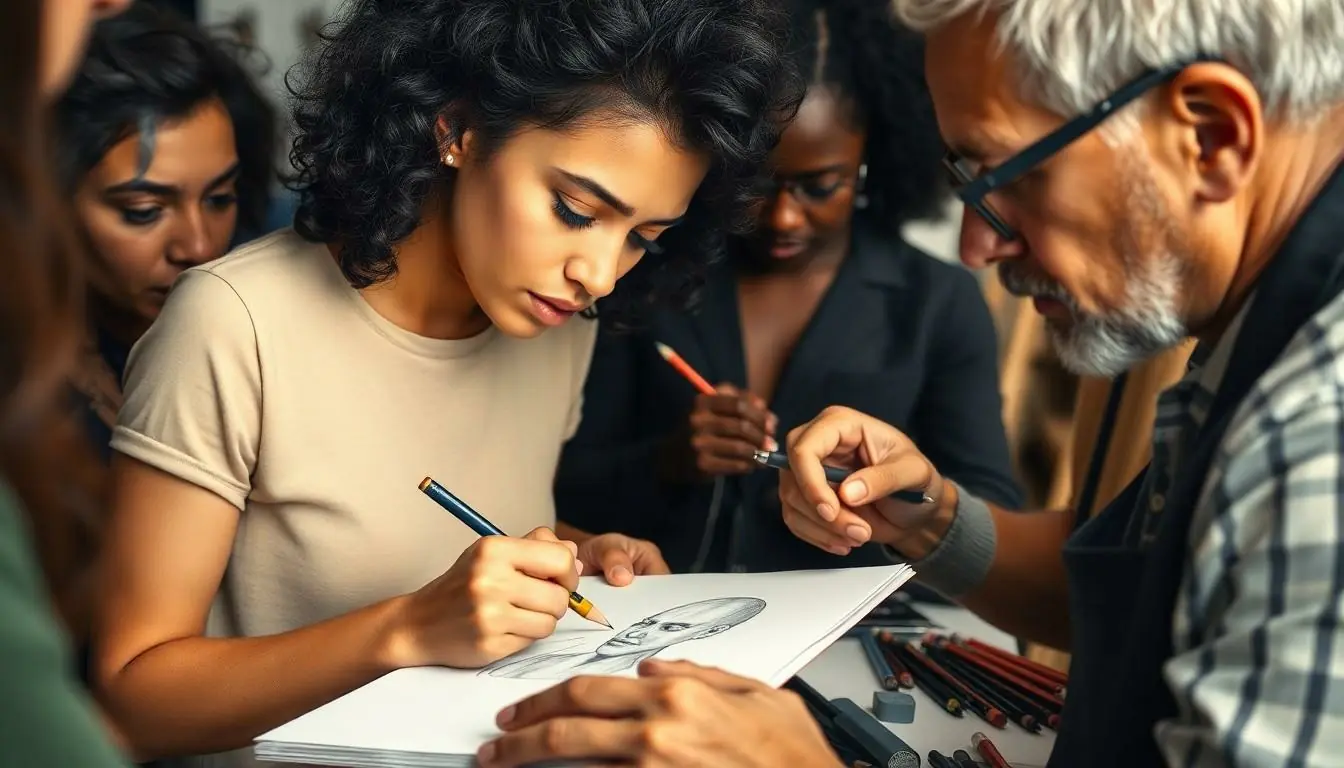Drawing a head might seem like a daunting task, but it’s easier than trying to explain your favorite meme to your grandma. Everyone’s got a head, so why not learn to draw one? Whether you’re a seasoned artist or just someone who doodles during meetings, capturing the essence of a head can be both fun and rewarding.
Table of Contents
ToggleOverview of Drawing of a Head
Drawing a head involves understanding its fundamental shapes and proportions. Artists often start with an oval shape to represent the skull. This basic outline acts as a framework for precision and accuracy.
Facial features play a crucial role in capturing likeness. Eyes, nose, and mouth placement align with specific measurement guidelines. Typically, the eyes sit halfway down the head, the nose’s bottom aligns with the chin’s halfway point, and the mouth’s center rests between the nose and chin.
Expressions add another layer of complexity to head drawing. Artists can convey emotions through subtle changes in features. A slight alteration in eye shape or mouth curvature significantly impacts expression.
Lighting and shading enhance the three-dimensional aspect. Artists often use soft gradients to show how light interacts with shapes. Shadows define volume and help depict realistic contours of the face.
Practice promotes improvement. Regular sketching aids in memorizing proportions and refining techniques. Many artists recommend using reference images for better accuracy.
Ultimately, drawing a head challenges creativity and technical skills. Embracing the process opens doors to artistic growth. Each drawing serves as an opportunity to learn and develop a personal style.
Techniques for Drawing Heads

Understanding techniques for drawing heads enhances artistic skills significantly. Mastering proportions and anatomy forms the foundation for realistic representations.
Proportions and Anatomy
Proportions dictate the placement of facial features. The average human face is divided into sections: from the hairline to the eyebrows, from the eyebrows to the nose, and from the nose to the chin. Each section typically measures about one-third of the total face length. Eyes generally sit halfway down the head, with the spacing between them equal to one eye width. Additionally, features like the mouth and ears align with specific reference points on the head. Familiarizing oneself with these proportions allows for a more accurate depiction of facial structure. Studying anatomy also aids in understanding underlying bone and muscle structures, which influence how skin drapes and how expressions change, making the drawing more lifelike.
Essential Tools and Materials
Gathering the right tools simplifies the drawing process. Graphite pencils in varying hardness grades create versatility in line quality. Charcoal pencils offer rich depth, while fine liners provide crisp details. High-quality sketch paper prevents smudging and supports various media. Artists often benefit from an eraser for corrections and a blending stump for smooth transitions. A ruler aids in maintaining proportions, and reference images serve as valuable guides. Using these tools effectively enhances the drawing experience. Investing time in choosing materials that suit one’s style can dramatically improve the results.
Styles of Head Drawing
Various styles exist when it comes to drawing a head. Different artists favor distinct approaches, influenced by their objectives and techniques.
Realistic vs. Abstract Approaches
Realistic approaches focus on capturing true likeness by meticulously observing proportions and details. Artists utilize reference images to create accurate representations of human features. Shading techniques enhance depth and volume, making drawings appear lifelike. In contrast, abstract approaches often simplify or distort features to convey emotion or thematic elements. Such styles emphasize creativity, allowing for personal expression rather than accuracy. Both methods offer unique challenges and benefits, catering to diverse artistic preferences.
Influential Artists and Their Techniques
Numerous artists have made significant contributions to head drawing, setting standards with their distinctive techniques. Leonardo da Vinci emphasized anatomical accuracy and expressive details, creating a lasting impact on realism. Pablo Picasso, known for cubism, transformed head drawing by reinterpreting forms and presenting multiple perspectives within a single artwork. Frida Kahlo’s unique personal style showcased emotive portrayals, utilizing vibrant colors and symbolism. Contemporary artists continue to draw inspiration from these masters, blending traditional techniques with modern interpretations. Through their innovations, they expand the possibilities of head drawing in contemporary art.
Common Challenges in Drawing Heads
Drawing heads poses unique challenges for many artists, particularly when addressing proportions and facial expressions. Understanding these challenges facilitates improvement in technique.
Overcoming Proportion Issues
Proportions serve as the backbone of head drawing. Recognizing the average divisions of the face helps establish a solid foundation. Artists often struggle with maintaining accuracy, especially when transitioning between various angles. Utilizing guidelines like the rule of thirds assists in placing features correctly. Concentrating on distances between the eyes, nose, and mouth ensures that each element aligns proportionately. Practicing from reference images reinforces these concepts. Effective use of geometric shapes simplifies the initial sketch, allowing for adjustments along the way. Consistent attention to these details aids in achieving a more realistic outcome.
Capturing Expression and Emotion
Expression is crucial in conveying emotion through a drawing. Subtle alterations in features can significantly impact the overall message. Artists might find it challenging to depict emotions accurately without exaggeration. Focusing on the eyes, mouth, and eyebrows can enhance expressiveness. Minor shifts in their positioning and shape often yield different emotions. Observing real-life subjects while they display various feelings enhances one’s ability to replicate these nuances. Regular practice of drawing expressive faces can foster a deeper understanding of facial dynamics. Combining anatomical knowledge with artistic intuition promotes the creation of lifelike expressions.
Drawing a head is a rewarding journey that combines creativity with technical skill. By understanding proportions and practicing regularly, artists can unlock their potential and develop a unique style. Embracing both realistic and abstract techniques allows for personal expression while honoring the tradition set by great masters.
Overcoming challenges in capturing likeness and emotion is part of the learning process. With dedication and the right tools, anyone can improve their head drawing abilities. This art form not only enhances artistic skills but also deepens the appreciation for the human face and its myriad expressions.
